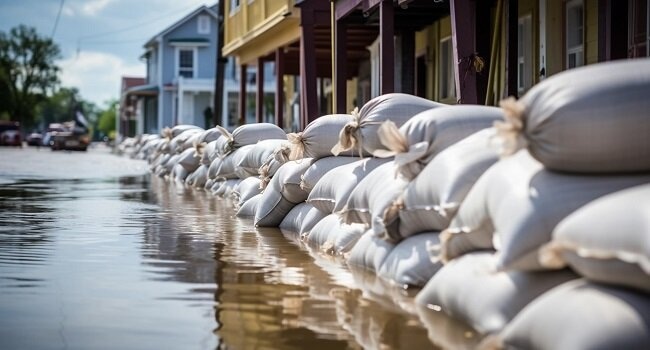Extreme flooding events are becoming more frequent across many regions as the climate continues to change. With this, efforts have been made to reinforce infrastructure and buildings to withstand the next flood. Advanced waterproofing materials and elevated foundation designs allow new construction to be flood-resilient.
We can greatly reduce the financial and human impacts when the next surge comes by adapting homes and critical facilities like hospitals to cope with floodwaters. While floods may be inevitable, damage no longer has to be. Through innovation, preparation, and proper design, we can build our towns to weather any storm.
Let’s explore different innovative construction techniques that aim to mitigate flood risk.
1. Elevated And Flood-Resilient Foundations
Elevating buildings on innovative raised foundations keeps living spaces safely above flood levels. Innovative foundations, such as helical piles, raise buildings higher off the ground, reducing vulnerability to floodwaters.
Making the foundation flood-proof protects the entire structure. Building codes should require minimum elevations for new construction in floodplains based on historical flood levels and future projections.
2. Flood-Resistant Building Materials
Advancements nowadays have led to the development of building materials that reduce flood risk. Building materials like porous concrete and permeable pavements permit stormwater to slowly soak into the ground rather than run off surfaces.
Flood-resistant drywall and insulation can withstand water exposure inside homes and buildings without warping or mold growth. Using these types of flood-resilient materials reduces costly flood damage and repairs. They provide passive flood protection without the need for temporary emergency flood barriers.
3. Modular And Prefabricated Construction
Modular and prefabricated building techniques are becoming more common as an adaptable and resilient construction method in flood-prone regions. Modular structures are designed in sections manufactured offsite and then transported and assembled on location. This allows for rapid construction or relocation if needed.
Modular homes are made with special vents, raised floors, and waterproof materials for residential buildings. They are easy to set up before a flood and take down after. It helps communities quickly prepare buildings for rising water dangers.
4. Green Infrastructure And Natural Flood Management
Implementing green infrastructure is an effective way to mimic natural hydrology and minimize flooding from heavy rainfall events. Green roofs with rainwater-capturing vegetation help divert stormwater. Rain gardens filled with native plants provide beautiful landscaping while absorbing runoff.
Strategic afforestation or reforesting along rivers and streams helps absorb excess precipitation. Wetland and floodplain restoration allows rivers to spill into retention basins naturally.
5. Smart Flood Monitoring And Alert Systems
Incorporating innovative technology into construction projects is a game-changer for flood mitigation. Sensor networks and real-time monitoring systems provide early flood warnings, allowing residents and authorities to take proactive measures.
Smart buildings equipped with flood sensors can automatically deploy flood protection measures.
6. Raised And Flood-Resistant Roads
Building elevated roads and bridges is one of the most impactful flood-resilient construction techniques for infrastructure. Major roadways are designed and constructed to rise above anticipated flood heights. This prevents roads from being submerged and unpassable during high-water events.
Building highways on dams and bridges allows transportation networks to remain operational even during severe flooding. Implementing flood-resistant roads requires an upfront investment, but the long-term savings are substantial.
7. Climate-Adaptive Design
Climate-adaptive design principles are durable, energy efficient, and made to evolve over decades of changing weather. Critical equipment and utilities are also relocated to higher floors or rooftops.
Waterproof and salt-resistant materials are used below flood elevation to prevent damage. Natural flood buffers like wetlands and rain gardens are incorporated into landscapes.
8. Community Engagement And Education
Engaging local communities and educating residents is crucial for resilient construction to make a real impact. Many people are unaware of their flood risks or how to protect their homes through proper design adaptations.
Outreach programs can teach homeowners flood-proofing techniques like elevating appliances, using flood barriers, and redirecting drainage. This allows individuals to actively reduce vulnerability, even in existing houses.
9. Government Regulations And Incentives
Government regulations and incentives like building codes, tax breaks, and resilience grants are essential to drive the widespread adoption of innovative flood-resistant construction.
By mandating resilient standards and financing mitigation projects, policymakers can normalize forward-looking development practices that will save lives and provide long-term economic benefits by reducing flood impacts.
Conclusion
As extreme weather events become more frequent, investing in resilient infrastructure and buildings is crucial to adapt to our changing climate. While the upfront costs of innovative flood mitigation can seem high, the long-term benefits for safety, sustainability, and cost savings are immense.

By elevating critical systems, using waterproof materials, implementing natural buffers, and embracing climate-adaptive design, we can develop communities that can survive and thrive in the face of future floods.






























